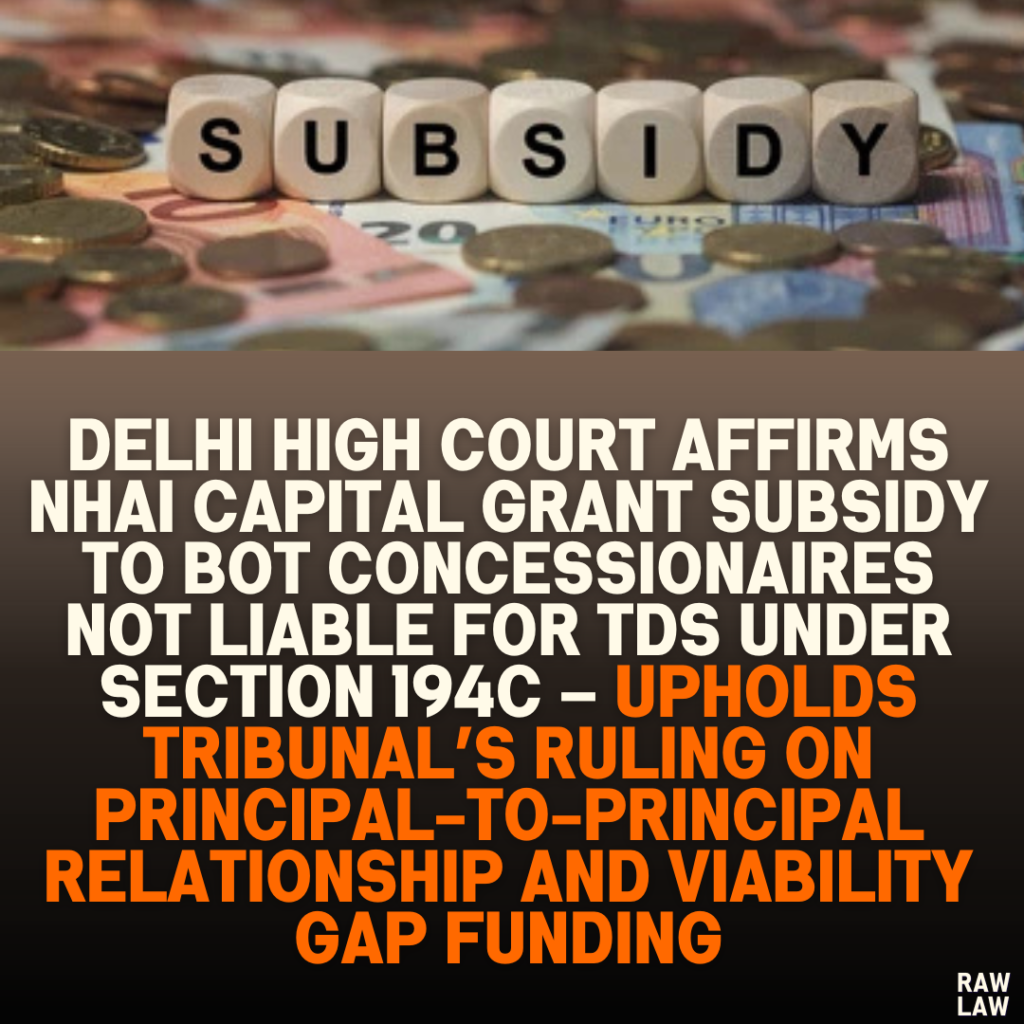Court’s Decision:
The Delhi High Court affirmed the Income Tax Appellate Tribunal’s (ITAT) ruling that capital grant subsidies provided by the National Highways Authority of India (NHAI) to concessionaires under concession agreements are not subject to withholding tax as per Section 194C of the Income Tax Act. The court noted that these payments are viability gap funding, not contractual payments for a work contract, and do not fall within the purview of Section 194C.
Facts:
The dispute arose when NHAI provided capital grants to concessionaires for constructing, maintaining, and operating highway projects under the Build-Operate-Transfer (BOT) model. The Assessing Officer (AO) had argued that NHAI should deduct tax at source on these grants under Section 194C, interpreting them as payments for contractual work. However, the Tribunal and subsequently the High Court found that these grants were essentially viability gap funding intended to make the projects financially feasible for concessionaires, rather than payments for work performed directly for NHAI.
Issues:
- Whether capital grants disbursed by NHAI to concessionaires constitute contractual payments liable to tax deduction under Section 194C.
- Whether the Tribunal correctly held that these grants are a form of financial support and do not fall within the scope of a “work” contract under Section 194C.
Petitioner’s Arguments:
The petitioner, Commissioner of Income Tax, argued that Section 194C is applicable to any payment made to a contractor for carrying out a work. They contended that these grants were payments made under a contract and should, therefore, be subject to withholding tax.
Respondent’s Arguments:
The respondent, NHAI, argued that the capital grant is a subsidy provided as viability gap funding, ensuring project feasibility where concessionaires’ expected revenue falls short. NHAI maintained that the payments do not constitute work payments under Section 194C, as the funds are directed at supporting concessionaires’ operations rather than fulfilling a direct contractual obligation.
Analysis of the Law:
The High Court analyzed Section 194C of the Income Tax Act, which requires tax deduction at source for payments made to a contractor for carrying out any work under a contract. It referenced the Supreme Court’s interpretation, stating that “any work” in Section 194C has broad meaning but emphasized that the capital grants in this case do not meet the work requirements of the section. The grants, under BOT arrangements, were viewed as financial subsidies rather than payments for work directly commissioned by NHAI.
Precedent Analysis:
The High Court referred to earlier rulings, including the Jaipur Bench of the Tribunal, which had similarly held that viability gap funding under the BOT model does not qualify as a contractual payment requiring tax deduction. The court also relied on the Supreme Court’s ruling in Associated Cement Co. Ltd. v. CIT, which clarified the scope of “any work” under Section 194C.
Court’s Reasoning:
The court reasoned that the concessionaires under BOT agreements undertake highway construction and maintenance at their own risk and are permitted to collect tolls, implying ownership during the concession period. The capital grant, structured as viability gap funding, is disbursed not as remuneration for a contractual obligation but as financial aid to ensure project sustainability.
Conclusion:
The Delhi High Court upheld the Tribunal’s decision, concluding that the capital grants provided by NHAI to concessionaires do not fall under Section 194C for tax deduction purposes. The relationship between NHAI and concessionaires is not one of contractor and principal but rather one of principal and principal, given the BOT model’s structure.
Implications:
This ruling clarifies the treatment of capital subsidies under concession agreements, specifically for projects structured under BOT models. It reaffirms that viability gap funding intended to support project feasibility is not subject to withholding tax under Section 194C, impacting similar projects and governmental support schemes in infrastructure development.




Pingback: Bombay High Court Affirms Life Sentence for Calculated and Brutal Murder - “No Provocation; Deliberate Use of Deadly Weapons and Crushing Indicates Premeditated Intent to Kill” - Raw Law